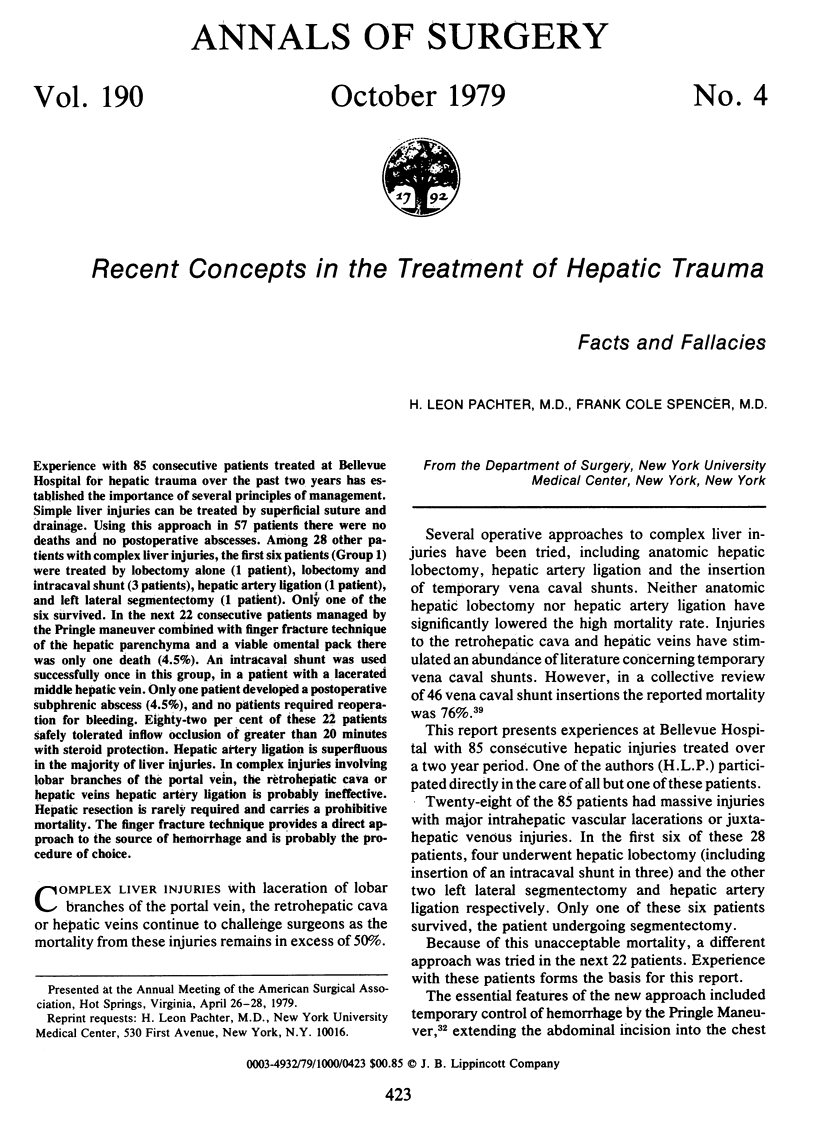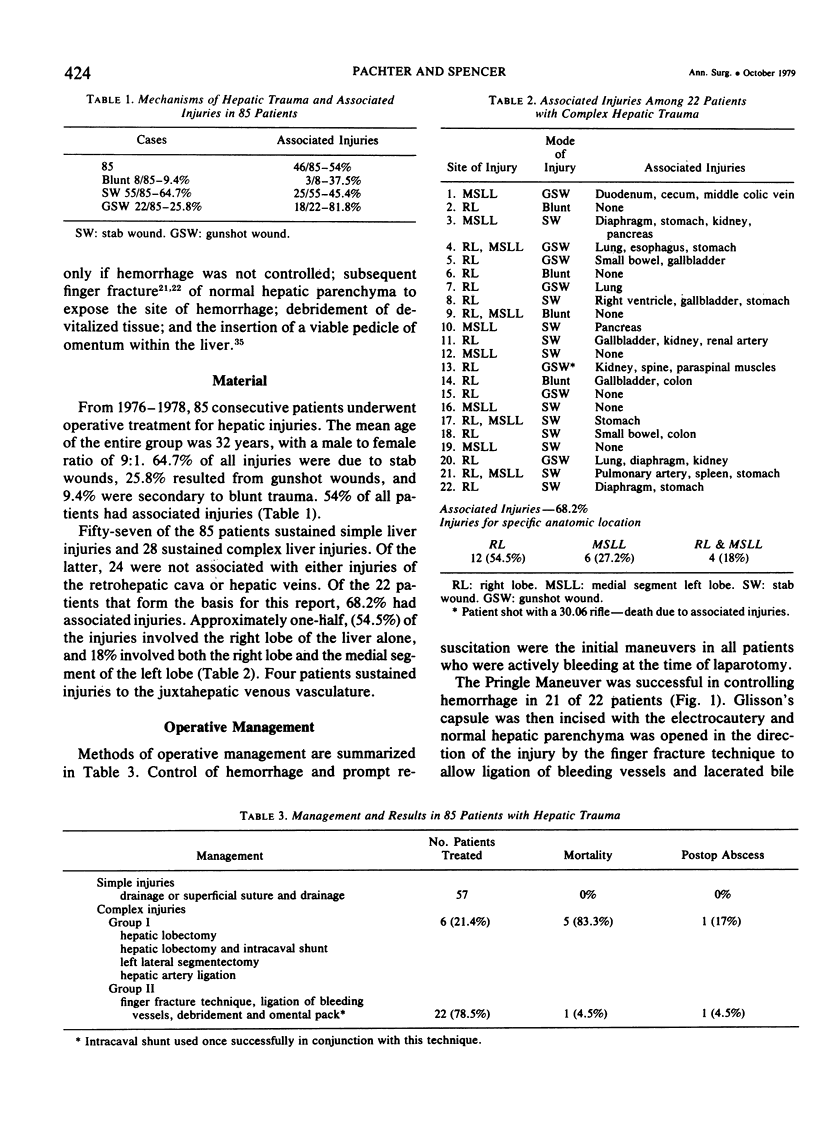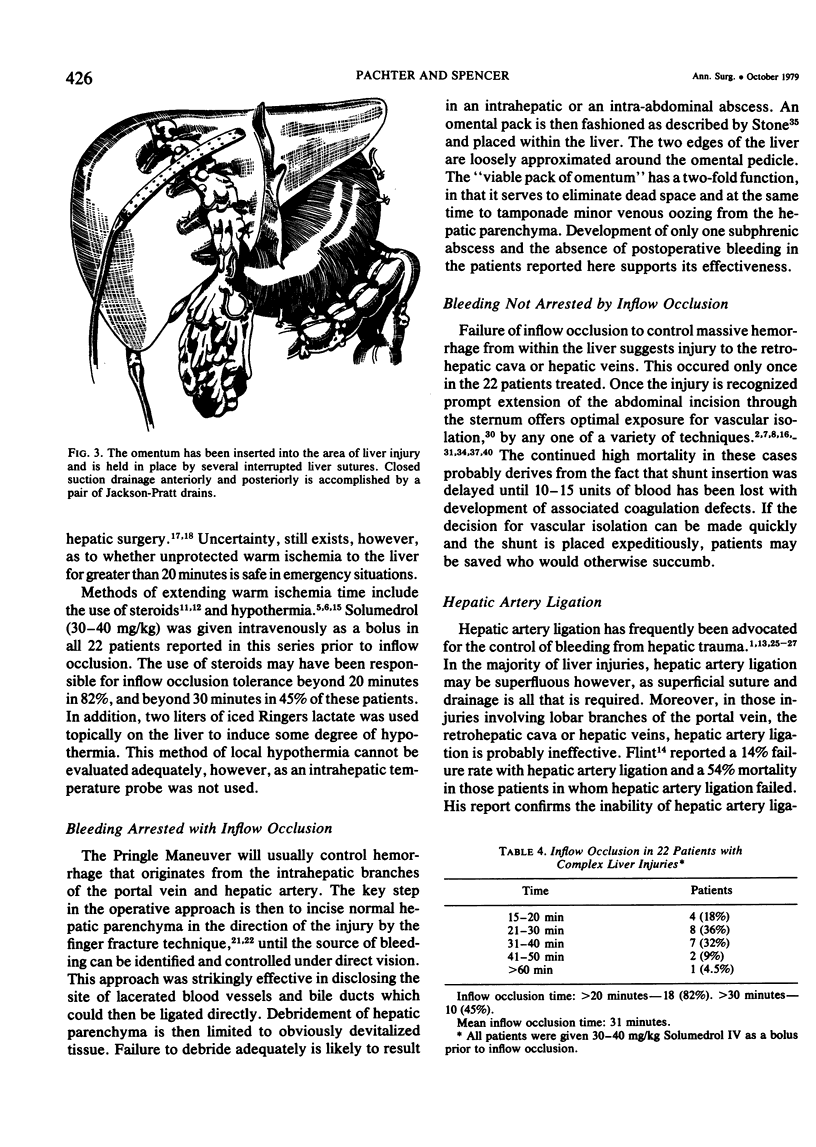Abstract
Experience with 85 consecutive patients treated at Bellevue Hospital for hepatic trauma over the past two years has established the importance of several principles of management. Simple liver injuries can be treated by superficial suture and drainage. Using this approach in 57 patients there were no deaths and no postoperative abscesses. Among 28 other patients with complex liver injuries, the first six patients (Group 1) were treated by lobectomy alone (1 patient), lobectomy and intracaval shunt (3 patients), hepatic artery ligation (1 patient), and left lateral segmentectomy (1 patient). Only one of the six survived. In the next 22 consecutive patients managed by the Pringle maneuver combined with finger fracture technique of the hepatic parenchyma and a viable omental pack there was only one death (4.5%). An intracaval shunt was used successfully once in this group, in a patient with a lacerated middle hepatic vein. Only one patient developed a postoperative subphrenic abscess (4.5%), and no patients required reoperation for bleeding. Eighty-two per cent of these 22 patients safely tolerated inflow occlusion of greater than 20 minutes with steroid protection. Hepatic artery ligation is superfluous in the majority of liver injuries. In complex injuries involving lobar branches of the portal vein, the retrohepatic cava or hepatic veins hepatic artery ligation is probably ineffective. Hepatic resection is rarely required and carries a prohibitive mortality. The finger fracture technique provides a direct approach to the source of heniorrhage and is probably the procedure of choice.
Full text
PDF





Selected References
These references are in PubMed. This may not be the complete list of references from this article.
- Aaron S., Fulton R. L., Mays E. T. Selective ligation of the hepatic artery for trauma of the liver. Surg Gynecol Obstet. 1975 Aug;141(2):187–189. [PubMed] [Google Scholar]
- Aaron W. S., Mays E. T. Isolation of the retrohepatic vena cava by balloon catheter: an experimental assessment. Rev Surg. 1975 May-Jun;32(3):222–225. [PubMed] [Google Scholar]
- BERNHARD W. F., CAHILL G. F., Jr, CURTIS G. W. The rationale of surgery under hypothermia in certain patients with severe hepatocellular disease. Ann Surg. 1957 Mar;145(3):289–303. doi: 10.1097/00000658-195703000-00001. [DOI] [PMC free article] [PubMed] [Google Scholar]
- BERNHARD W. F., McMURREY J. D., CURTIS G. W. Feasibility of partial hepatic resection under hypothermia. N Engl J Med. 1955 Aug 4;253(5):159–164. doi: 10.1056/NEJM195508042530501. [DOI] [PubMed] [Google Scholar]
- Bricker D. L., Morton J. R., Okies J. E., Beall A. C., Jr Surgical management of injuries to the vena cava: changing patterns of injury and newer techniques of repair. J Trauma. 1971 Sep;11(9):725–735. doi: 10.1097/00005373-197109000-00001. [DOI] [PubMed] [Google Scholar]
- Brown R. S., Boyd D. R., Matsuda T., Lowe R. J. Temporary internal vascular shunt for retrohepatic vena cava injury. J Trauma. 1971 Sep;11(9):736–737. doi: 10.1097/00005373-197109000-00002. [DOI] [PubMed] [Google Scholar]
- Carroll C. P., Cass K. A., Whelan T. J., Jr Wounds of the liver in Vietnam: a critical analysis of 254 cases. Ann Surg. 1973 Apr;177(4):385–392. doi: 10.1097/00000658-197304000-00001. [DOI] [PMC free article] [PubMed] [Google Scholar]
- Defore W. W., Jr, Mattox K. L., Jordan G. L., Jr, Beall A. C., Jr Management of 1,590 consecutive cases of liver trauma. Arch Surg. 1976 Apr;111(4):493–497. doi: 10.1001/archsurg.1976.01360220189033. [DOI] [PubMed] [Google Scholar]
- Figueroa I., Santiago-Delpín E. A. Steroid protection of the liver during experimental eschemia. Surg Gynecol Obstet. 1975 Mar;140(3):368–370. [PubMed] [Google Scholar]
- Flint L. M., Mays E. T., Aaron W. S., Fulton R. L., Polk H. C. Selectivity in the management of hepatic trauma. Ann Surg. 1977 Jun;185(6):613–618. doi: 10.1097/00000658-197706000-00001. [DOI] [PMC free article] [PubMed] [Google Scholar]
- Flint L. M., Mays E. T., Aaron W. S., Fulton R. L., Polk H. C. Selectivity in the management of hepatic trauma. Ann Surg. 1977 Jun;185(6):613–618. doi: 10.1097/00000658-197706000-00001. [DOI] [PMC free article] [PubMed] [Google Scholar]
- Fortner J. G., Shiu M. H., Kinne D. W., Kim D. K., Castro E. B., Watson R. C., Howland W. S., Beattie E. J., Jr Major hepatic resection using vascular isolation and hypothermic perfusion. Ann Surg. 1974 Oct;180(4):644–652. doi: 10.1097/00000658-197410000-00030. [DOI] [PMC free article] [PubMed] [Google Scholar]
- Heaney J. P., Stanton W. K., Halbert D. S., Seidel J., Vice T. An improved technic for vascular isolation of the liver: experimental study and case reports. Ann Surg. 1966 Feb;163(2):237–241. doi: 10.1097/00000658-196602000-00013. [DOI] [PMC free article] [PubMed] [Google Scholar]
- Huguet C., Nordlinger B., Bloch P., Conard J. Tolerance of the human liver to prolonged normothermic ischemia. A biological study of 20 patients submitted to extensive hepatectomy. Arch Surg. 1978 Dec;113(12):1448–1451. doi: 10.1001/archsurg.1978.01370240070012. [DOI] [PubMed] [Google Scholar]
- Huguet C., Nordlinger B., Galopin J. J., Bloch P., Gallot D. Normothermic hepatic vascular exclusion for extensive hepatectomy. Surg Gynecol Obstet. 1978 Nov;147(5):689–693. [PubMed] [Google Scholar]
- Levin A., Gover P., Nance F. C. Surgical restraint in the management of hepatic injury: a review of Charity Hospital Experience. J Trauma. 1978 Jun;18(6):399–404. doi: 10.1097/00005373-197806000-00004. [DOI] [PubMed] [Google Scholar]
- Lim R. C., Jr, Lau G., Steele M. Prevention of complications after liver trauma. Am J Surg. 1976 Aug;132(2):156–162. doi: 10.1016/0002-9610(76)90041-6. [DOI] [PubMed] [Google Scholar]
- Lin T. Y. Results in 107 hepatic lobectomies with a preliminary report on the use of a clamp to reduce blood loss. Ann Surg. 1973 Apr;177(4):413–421. doi: 10.1097/00000658-197304000-00006. [DOI] [PMC free article] [PubMed] [Google Scholar]
- Lucas C. E., Ledgerwood A. M. Liver necrosis following hepatic artery transection due to trauma. Arch Surg. 1978 Sep;113(9):1107–1107. doi: 10.1001/archsurg.1978.01370210089014. [DOI] [PubMed] [Google Scholar]
- Lucas C. E., Ledgerwood A. M. Prospective evaluation of hemostatic techniques for liver injuries. J Trauma. 1976 Jun;16(6):442–451. doi: 10.1097/00005373-197606000-00003. [DOI] [PubMed] [Google Scholar]
- Lucas C. E., Ledgerwood A. M. Prospective evaluation of hemostatic techniques for liver injuries. J Trauma. 1976 Jun;16(6):442–451. doi: 10.1097/00005373-197606000-00003. [DOI] [PubMed] [Google Scholar]
- Madding G. F., Kennedy P. A. Hepatic artery ligation. Surg Clin North Am. 1972 Jun;52(3):719–728. doi: 10.1016/s0039-6109(16)39744-4. [DOI] [PubMed] [Google Scholar]
- Mays E. T. Vascular occlusion. Surg Clin North Am. 1977 Apr;57(2):291–323. doi: 10.1016/s0039-6109(16)41184-9. [DOI] [PubMed] [Google Scholar]
- McInnis W. D., Richardson J. D., Aust J. B. Hepatic trauma: pitfalls in management. Arch Surg. 1977 Feb;112(2):157–161. doi: 10.1001/archsurg.1977.01370020051005. [DOI] [PubMed] [Google Scholar]
- McMaster P., Medd R. Total hepatic ischaemia in the Rhesus monkey. Br J Surg. 1977 Nov;64(11):819–821. doi: 10.1002/bjs.1800641117. [DOI] [PubMed] [Google Scholar]
- Miller D. R. Median sternotomy extension of abdominal incision for hepatic lobectomy. Ann Surg. 1972 Feb;175(2):193–196. doi: 10.1097/00000658-197202000-00006. [DOI] [PMC free article] [PubMed] [Google Scholar]
- Pilcher D. B., Harman P. K., Moore E. E., Jr Retrohepatic vena cava balloon shunt introduced via the sapheno-femoral junction. J Trauma. 1977 Nov;17(11):837–841. doi: 10.1097/00005373-197711000-00003. [DOI] [PubMed] [Google Scholar]
- Pringle J. H. V. Notes on the Arrest of Hepatic Hemorrhage Due to Trauma. Ann Surg. 1908 Oct;48(4):541–549. doi: 10.1097/00000658-190810000-00005. [DOI] [PMC free article] [PubMed] [Google Scholar]
- RAFFUCCI F. L. The effects of temporary occlusion of the afferent hepatic circulation in dogs. Surgery. 1953 Mar;33(3):342–351. [PubMed] [Google Scholar]
- Santiago Delpín E. A., Figueroa I., López R., Vázquez J. Protective effect of steroids on liver ischemia. Am Surg. 1975 Nov;41(11):683–685. [PubMed] [Google Scholar]
- Schrock T., Blaisdell F. W., Mathewson C., Jr Management of blunt trauma to the liver and hepatic veins. Arch Surg. 1968 May;96(5):698–704. doi: 10.1001/archsurg.1968.01330230006002. [DOI] [PubMed] [Google Scholar]
- Stone H. H., Lamb J. M. Use of pedicled omentum as an autogenous pack for control of hemorrhage in major injuries of the liver. Surg Gynecol Obstet. 1975 Jul;141(1):92–94. [PubMed] [Google Scholar]
- Storm F. K., Longmire W. P., Jr A simplified clamp for hepatic resection. Surg Gynecol Obstet. 1971 Jul;133(1):103–104. [PubMed] [Google Scholar]
- Testas P., Bénichou J., Benhamou M., Chanzy M. Vascular exclusion in surgery of the liver: experimental basis, technic, and clinical results. Am J Surg. 1977 Jun;133(6):692–696. doi: 10.1016/0002-9610(77)90155-6. [DOI] [PubMed] [Google Scholar]
- Trunkey D. D., Shires G. T., Mc Clelland R. Management of liver trauma in 811 consecutive patients. Ann Surg. 1974 May;179(5):722–728. doi: 10.1097/00000658-197405000-00026. [DOI] [PMC free article] [PubMed] [Google Scholar]
- Walt A. J. Founder's lecture: The mythology of hepatic trauma--or Babel revisited. Am J Surg. 1978 Jan;135(1):12–18. doi: 10.1016/0002-9610(78)90003-x. [DOI] [PubMed] [Google Scholar]
- Yellin A. E., Chaffee C. B., Donovan A. J. Vascular isolation in treatment of juxtahepatic venous injuries. Arch Surg. 1971 Jun;102(6):566–573. doi: 10.1001/archsurg.1971.01350060030010. [DOI] [PubMed] [Google Scholar]


